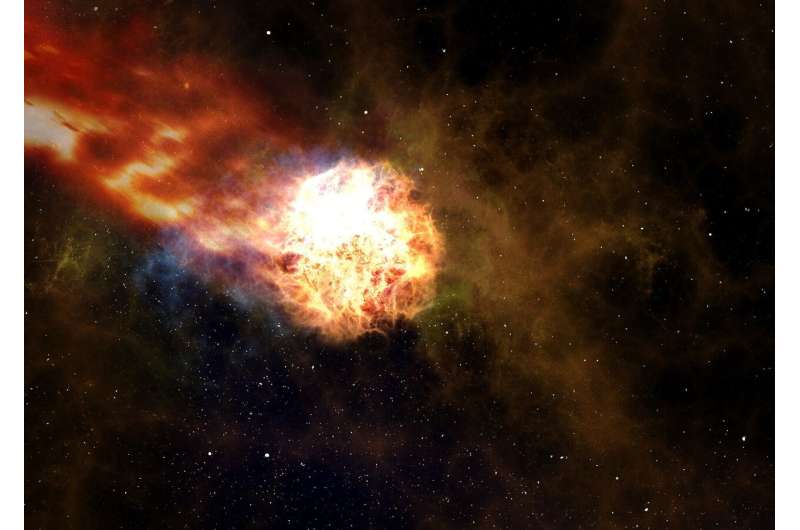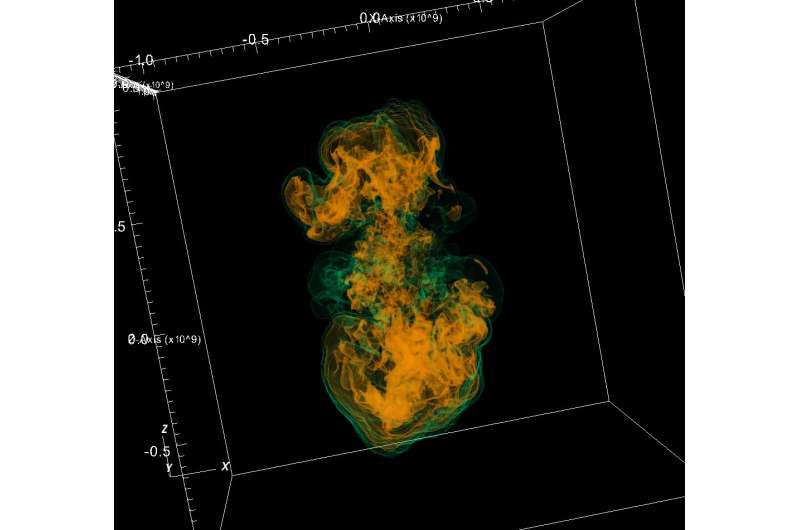Scientists reveal new insights of exploding massive stars and future gravitational wave detectors

In a study recently published in the Monthly Notices of the Royal Astronomical Society, Dr. Jade Powell and Dr. Bernhard Mueller from the ARC Centre of Excellence for Gravitational Wave Discovery (OzGrav) simulated three core-collapse supernovae using supercomputers from across Australia, including the OzSTAR supercomputer at Swinburne University of Technology. The simulation models—which are 39 times, 20 times and 18 times more massive than our sun— revealed new insights into exploding massive stars and the next generation of gravitational-wave detectors.
Core-collapse supernovae are the explosive deaths of massive stars at the end of their lifetime. They are some of the most luminous objects in the universe and are the birthplace of black holes and neutron stars. The gravitational waves detected from these supernovae help scientists better understand the astrophysics of black holes and neutron stars.
Future advanced gravitational-wave detectors, engineered to be more sensitive, could possibly detect a supernova—a core-collapse supernova could be the first object to be observed simultaneously in electromagnetic light, neutrinos and gravitational waves.
To detect a core-collapse supernova in gravitational waves, scientists need to predict what the gravitational wave signal will look like. They use supercomputers to simulate these cosmic explosions to understand their complicated physics. This allows them to predict what the detectors will see when a star explodes and its observable properties.
In the study, the simulations of three exploding massive stars follow the operation of the supernova engine over a long duration—this is important for accurate predictions of the neutron star masses and observable explosion energy.

OzGrav postdoctoral researcher Jade Powell says, "Our models are 39 times, 20 times and 18 times more massive than our sun. The 39-solar mass model is important because it's rotating very rapidly, and most previous long duration core-collapse supernova simulations do not include the effects of rotation."
The two most massive models produce energetic explosions powered by the neutrinos, but the smallest model did not explode. Stars that do not explode emit lower amplitude gravitational waves, but the frequency of their gravitational waves lies in the most sensitive range of gravitational wave detectors.
"For the first time, we showed that rotation changes the relationship between the gravitational-wave frequency and the properties of the newly-forming neutron star," explains Powell.
The rapidly rotating model showed large gravitational-wave amplitudes that would make the exploding star detectable almost 6.5 million light years away by the next generation of gravitational-wave detectors, like the Einstein Telescope.
More information: Jade Powell et al. Three-dimensional core-collapse supernova simulations of massive and rotating progenitors, Monthly Notices of the Royal Astronomical Society (2020). DOI: 10.1093/mnras/staa1048
Journal information: Monthly Notices of the Royal Astronomical Society



















